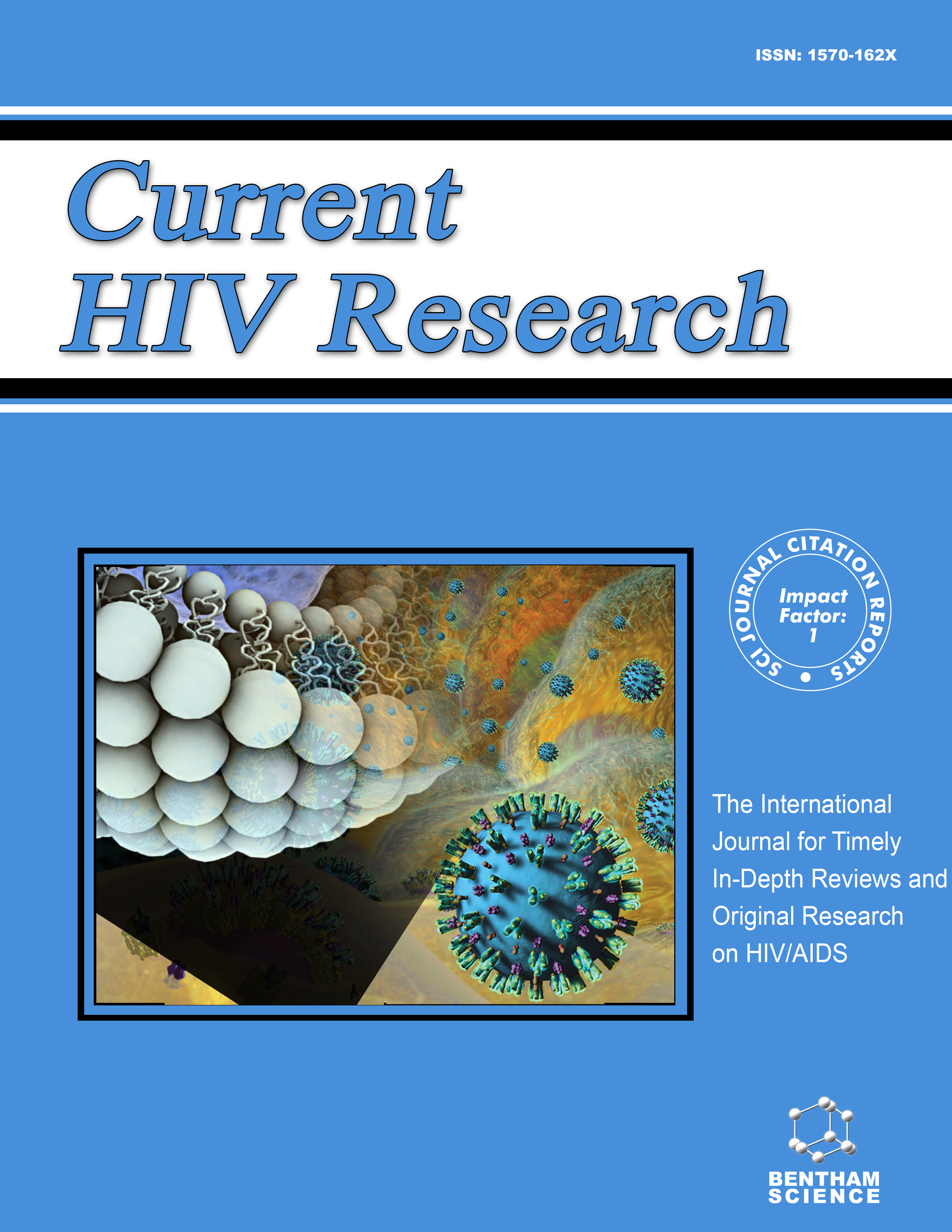- Home
- A-Z Publications
- Current HIV Research
- Previous Issues
- Volume 5, Issue 4, 2007
Current HIV Research - Volume 5, Issue 4, 2007
Volume 5, Issue 4, 2007
-
-
HIV-1 Integrase: From Biology to Chemotherapeutics
More LessAIDS has claimed the lives of 25 million people worldwide, an additional 40 million people are HIV-infected and new cases are being diagnosed every year. Despite the fact that HAART has moved AIDS from the category of terminal diseases to that of treatable chronic illnesses, its long-term therapeutic success may be compromised by the development of resistance to the currently used drugs. Despite the availability of RT, P Read More
-
-
-
Oral Glucose Loading for Detection of Mitochondrial Toxicity During HAART in HIV-Infected Patients
More LessAuthors: Hadewych J.M. ter Hofstede, George F. Borm and Peter P. KoopmansNucleoside reverse transcriptase inhibitors used in antiretroviral therapy may cause mitochondrial toxicity. Mitochondrial dysfunction leads to disturbance of the glucose metabolism, resulting in an accumulation of L-lactate. We tested the hypothesis that an oral glucose tolerance test (OGTT) can be used to detect mitochondrial toxicity in patients on antiretroviral nucleoside analogues. An OGTT was performed in 30 su Read More
-
-
-
Rev-Dependent Indicator T Cell Line
More LessAuthors: Yuntao Wu, Margaret H. Beddall and Jon W. MarshMeasuring virion infectivity is critical for studying and monitoring the process of HIV-1 infection. The easiest and the most common method utilizes reporter cell lines based on the HIV LTR promoter. The early HIV gene product Tat amplifies expression from the LTR; however, there is a background transcriptional activity that is independent of Tat. Furthermore, LTR activity can be influenced by cellular activation states. W Read More
-
-
-
Oncogenic Properties of HIV-Tat in Colorectal Cancer Cells
More LessAuthors: Duy Huynh, Elizabeth Vincan, Theo Mantamadiotis, Damian Purcell, Chee-Kai Chan and Robert RamsayWith the advent of Highly-Active-Anti-Retroviral-Therapy (HAART), HIV patients can expect to live beyond 10-15 years following diagnosis. An unexpected result of increased survival is the emergence of opportunistic, oncogenic virus-associated cancers such as Burkitt's lymphoma (Epstein-Barr Virus), cervical cancer (Human Papilloma Virus) and Kaposi's sarcoma (Kaposi's sarcoma-associated herpesvirus) in this immuno-c Read More
-
-
-
The Antimicrobial Peptide LL-37 Inhibits HIV-1 Replication
More LessThe antimicrobial peptide LL-37 is the only cathelicidin that has been described in humans. LL-37 exerts chemotactic, immunomodulatory and angiogenic effects; activities that are mediated through binding to the formyl peptide receptor like (FPRL)-1 receptor. Agonistic ligation of FPRL-1 can also induce down-regulation of HIV-1 chemokine receptors and reduce susceptibility to HIV-1 infection in vitro. Therefore, we have e Read More
-
-
-
HIV-1-Discordant Couples in Sub-Saharan Africa: Explanations and Implications for High Rates of Discordancy
More LessAuthors: Brandon L. Guthrie, Guy de Bruyn and Carey FarquharIn sub-Saharan Africa, approximately 1 in 2 HIV-1-infected persons living in a couple have a serodiscordant partner. Recent data suggest a large proportion of new HIV-1 infections in mature epidemics occur within discordant couples, making discordancy a major contributor to the spread of HIV/AIDS in Africa. What accounts for high rates of HIV-1 discordance and why some individuals remain uninfected despite repeated sex Read More
-
-
-
Lability of Antiretroviral Drug Resistance Mutations - Correlates with Immunological and Virological Responses
More LessAuthors: Ali Al Mazari, Albert Y. Zomaya, Michael Charleston, Hanan Salem, AnnaMarie Maher and Roger J. GarsiaThis study assessed the relationship between changes in CD4 T-cell count, HIV Viral Load (VL) level and evolutionary patterns in Antiretroviral (ARV) resistance mutations of circulating HIV in those with persistent viraemia despite treatment. The study examined the dynamics of change in resistance mutations to explore potential predictors of evolution in the circulating virus over a prolonged period. Four longitudinal blood Read More
-
-
-
Clinical Ritonavir and Lopinavir Hypersensitivity Confirmed by a Specific In Vitro Cellular Allergen Stimulation Test
More LessAuthors: Roberto Manfredi, Sergio Sabbatani and Sergio BergonziA HIV-infected patient treated since eight years with all antiretroviral classes save boosted protease inhibitors, at the time of changing therapy due to an emerging genotyping resistance to non-nucleoside reverse transcriptase inhibitors, experienced repeated episodes of hypersensitivity reactions to all available boosted protease inhibitors. After documenting a combined ritonavir and lopinavir hypersensitivity by means of Read More
-
Volumes & issues
-
Volume 23 (2025)
-
Volume 22 (2024)
-
Volume 21 (2023)
-
Volume 20 (2022)
-
Volume 19 (2021)
-
Volume 18 (2020)
-
Volume 17 (2019)
-
Volume 16 (2018)
-
Volume 15 (2017)
-
Volume 14 (2016)
-
Volume 13 (2015)
-
Volume 12 (2014)
-
Volume 11 (2013)
-
Volume 10 (2012)
-
Volume 9 (2011)
-
Volume 8 (2010)
-
Volume 7 (2009)
-
Volume 6 (2008)
-
Volume 5 (2007)
-
Volume 4 (2006)
-
Volume 3 (2005)
-
Volume 2 (2004)
-
Volume 1 (2003)
Most Read This Month
Article
content/journals/chr
Journal
10
5
false
en


